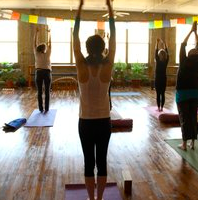Mind running wild? Slow the stallions and practice pratyahara.
As I was sorting through old home videos from my childhood recently, I came upon this one that reminded me of a Yogic analogy I’d read and appreciated, and was glad to revisit for personal awareness.
“Geez as soon as they saw the place, they started going nuts…one look and that was it, they wanted to run,” my dad said.
Sounds like what happens to me when I see a sale sign for cashews at Walgreen’s. (I know, nuts for nuts.)
In a collection of his teachings, Pathways to Joy, Swami Vivekananda said,
“It is easy to be active. Let the reins go and the horses will run anywhere they wish. Anyone can do that. But the person who can stop the plunging horses is the strong one. Which requires the greater strength: letting go or restraining? You must not mistake this sattva (the quality of true purity and illumination) for dullness or laziness. The calm person is the one who alone has great control over the mind waves, and his or her calmness is the manifestation of superior strength.
The mind is always trying to get back to its natural and pure state, but the senses draw it out. To restrain it, to check its outward tendency, and to start it on the return journey to the Essence of Intelligence, is the first step in Raja Yoga, because only in this way can the mind get on its proper course.”
Raja Yoga, or Royal Yoga, is the path of Yoga that is based upon discipline and concentration of the mind. While Raja Yoga encompasses all eight limbs of Patanjali’s system, the Raja yogi may be more specifically aimed towards the “higher” rungs that involve meditation and concentration.
“How to concentrate the mind, how to bring the mind completely under our control, is the whole subject of study in Raja Yoga,” Vivekananda says.
In Ashtanga yoga (the eight-limbed yoga), one of the practices for acquiring this concentration is pratyahara, or withdrawal of the senses. “Withdrawing the senses” doesn’t mean we don’t like our senses, don’t want to use or even enjoy them, but it means we learn to use them without being controlled by them.
Why would we want to control our senses, or our mind for that matter? In some schools of thought, the mind is considered a sense organ. Like the nose receives scent as input, the mind receives information as sensory input, and, poor mind, there is a LOT of information coming in! It can start to run rampant and wild…oscillating until we have no notion of what is True and what is just…mind muddle.
So if you don’t want to smell a fart…you, um, plug your nose! How do you “plug” the mind when the fluctuating is freaking you out? Meditation (and its encompassing practices and tools) is the way to clear air, so to speak.
Information—the mind’s sensory input—is brought in via the other five senses, so to harness this sixth sense, start with the first five: sight, smell, hearing, taste, and touch.
Is it time to take the reins? Practice pratyahara. If you are having trouble subduing the senses in your sitting meditation or your asana practice, take your practice to a location with very little sense distraction. A quiet room, dim light, cell phones off (unless it’s your timer!), comfortable temperature, etc. Set yourself up to succeed and know that it will cultivate the impression in your mind that there is nothing you are missing by retreating from sensory input. As you practice in this way, you may find that when input does try to shove at your senses, you realize you don’t need to accept it.
If I’m going to be all spiritually-flowery about it…I believe we have everything we need and could ever want inside. We don’t need the senses to draw on the peace that dwells within. We need to shut the senses up so we can turn in and find it!






Read 6 comments and reply